Keep Tips and Save Jobs in Communities of Color

(Photo: Lou Stejskal/Flickr)
As New York City businesses and their employees continue to adapt to shifting consumer habits, online competition, and increasing costs of doing business, New York State is dangerously close to further damaging the chances of business and employee success by eliminating the tipped wage credit.
This tip credit allows restaurant owners to pay tipped workers $8.65 per hour so long as tips ensure that the employee is earning at least the minimum wage at the end of the day.
The city’s family-owned restaurants and cafes aren’t shortchanging their employees to make a quick buck – they’re trying to make ends meet and take care of their servers at the same time. Surveys show that, on average, tipped workers end up earning as much as $25 an hour, with tips.
In this city, it’s notoriously difficult for locally owned and operated restaurants to survive.
As one restaurant owner from Harlem told me, “My customers expect me to compete with the best food and the best service as the best restaurants in town, but they want Harlem prices. It’s very hard and eliminating the tip credit will push me over the edge.” This is the sentiment throughout the city’s less affluent areas and outer-boroughs, where restaurant owners of color have been fighting to keep the tipped wage credit in place.
We celebrate birthdays, anniversaries, and graduations at family-owned neighborhood restaurants; they’re essential to the economic and cultural vitality of communities of color in every borough. They employ locals, from a handful to a few dozen each, and sometimes those employees have been with them for decades. These jobs are important to these workers and their families, and when tips are included, they are paid well over the minimum wage.
Most restaurant owners care deeply about their servers and want to pay them as best they can while still staying in business. If New York State eliminates the tip credit, labor costs will soar, jumping approximately 50 percent overnight. That massive increase will force tough choices, starting with cutting employees and reducing hours. But fewer employees means slower service, and no restaurant can survive a reputation for poor service. It’s a downward spiral that will close many restaurants permanently, and communities of color can least afford it.
We support good-faith, smart solutions to increase wages sustainably and fairly and promote small businesses throughout the city. That’s why we need to preserve the credit for tipped workers. These workers don’t want to lose their tips and can’t afford a pay cut. And they certainly don’t want to lose their jobs. This is a critical issue for communities of color, and our state leaders must get right – or risk causing more harm than they intend.
***
Jessica Walker is President of the Manhattan Chamber of Commerce. On Twitter @jessinharlem & @ManhattanCofC.
***
Have an op-ed idea or submission for Gotham Gazette? Email This email address is being protected from spambots. You need JavaScript enabled to view it.
An Opportunity to Offer Real Election Reform in New York City

(photo: Gotham Gazette)
Last Tuesday during the Ohio-12 special election, Americans found themselves angry at third party voters – again – for “wasting” their votes.
This problem is not unique to Ohio: in multi-candidate competitive races, we see upset voters of one party or candidate hold others accountable for their loss.
The blame should not be placed on voters -- it should be on the broken election system. Just look at New York City.
New York City primaries are crowded fields, with sometimes with as many as seven people vying for one ballot line.
Since 2009 there have been 121 primary elections in the city; 33.8% of these primaries were two-candidate races and 66.1% were more-than-two-candidate races.
Just during last year’s primary election cycle alone there were 38 elections. While 17 of these primaries had two candidates, the remaining 21 races had more than two candidates.
Of those 21 races, roughly 61.9% were won with less than 50% of the vote.
By supporting Ranked Choice Voting in New York City, Mayor de Blasio can help end the blame game.
Ranked Choice Voting allows voters to rank candidates from first to last choice on their ballots.
A candidate who collects a majority of the vote wins. If there’s no majority, then the last-place candidate is eliminated and their votes re-allocated according to the second preference of their voters. The process is repeated until there’s a majority winner.
It provides many benefits to voters, building majority support for candidates in multi-candidate races, inspiring voters to vote their preference - not the lesser of two evils - and avoiding costly run-offs.
Constituents are best served when their elected representative is able to garner majority support, while the elected official benefits from a broader base of support as well.
Ranked Choice Voting would avoid the troubling pattern of anti-democratic electoral outcomes in New York City. Candidates would move to the general election with majority support from their district.
Right now, the mayor’s Charter Revision Commission is reviewing recommendations before making proposals for the November New York City ballot. The 15-member commission has the opportunity to help transform the way New Yorkers vote.
History has its eyes on the them.
***
Susan Lerner is the executive director of Common Cause-NY. On Twitter @commoncauseny.
***
Have an op-ed idea or submission for Gotham Gazette? Email This email address is being protected from spambots. You need JavaScript enabled to view it.
Federal Corporate Tax Cuts Just Gave New Billions to New York Businesses - What About the MTA?
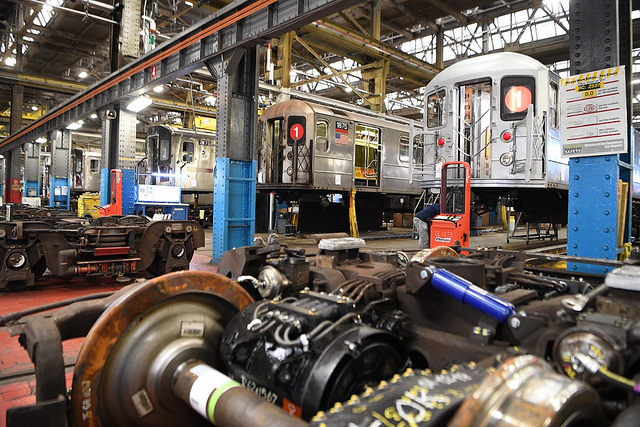
(Photo: Don Pollard/Office of Governor Andrew M. Cuomo)
There is a sudden new source of money in New York that is getting little attention in the debate about where the MTA will get resources to fund the ambitious plans to solve its problems, let alone just manage to keep the mass transit system going. That source is the big corporate income tax cuts just enacted by the federal government that have put billions - yes, billions - of dollars into the hands of New York businesses and their owners.
There are several reasons why tapping this resource makes sense. First, the size of the cash savings to New York businesses is so large that utilizing even a billion dollars a year would just be a portion of the money newly sitting in corporate pockets, even if restricted to businesses in the New York City area. Second, unlike individual income and property taxes, business taxes remain fully deductible at the federal level. Third, the mass transit systems that deliver millions of workers to these businesses are the lifeline for that wealth, and the state’s businesses should participate in a responsible effort to address this issue, as they did in 2008 when New York business leadership supported a payroll tax.
Still, Congestion Pricing Must Stay on The Table
Consideration of this revenue source is by no means intended to exclude congestion pricing, which will return to the table early in 2019, during state budget negotiations. The truth is that the MTA needs twice as much, or more, than the revenue congestion pricing can deliver. The congestion pricing plan developed by the “Fix NYC” panel put together by Governor Cuomo includes a Manhattan business district entry fee that would total about $1 billion a year (excluding the new taxi/app-vehicle tax, which was enacted). But to pay for the MTA’s current capital plan, and then pay for the new “Fast Forward” plan put forth by MTA New York City Transit President Andy Byford on top of it, will require double the size of the congestion pricing fee, and more.
The MTA itself made the case at its end-of-July board meeting. The presentation of the July 2018 MTA Financial Plan update and the 2019 Preliminary Budget began with this overriding statement: “As stated in the November and February plans, the MTA requires new sources of sustainable revenue for operations and capital.”
The board heard the dry numbers that predicted growing operating deficits from 2020 to 2022 despite 4% fare and toll hikes in 2019 and 2021. The deficit is projected to be $200 million in 2020, $400 million in 2021, and $600 million in 2022. A few weeks before the board meeting, Governor Cuomo reiterated his support for congestion pricing and said the MTA needed $37 billion, the necessary portion of which he proposed the state split with New York City. This is political rhetoric. Neither Cuomo nor de Blasio wants to divert resources from their budgets to provide steep new revenue sources to the MTA. New sources of money are required.
The MTA’s Problem
The main problem with paying for mass transit is the MTA capital budget. The MTA can manage to cover the expenses of its operating budget within the constraints of fares, tolls, and dedicated taxes, but not its capital budget.
The money needed to replace track, stations, rolling stock, legacy signals, advanced signals, the expansion projects, and more requires external funding sources. The capital budget needs government grants and/or borrowed funds. Borrowed funds means paying interest, and that is a major, growing issue. When you need $37 billion, and most of it won’t come from grants, that’s a lot of borrowing and a lot of interest to pay. Congestion pricing is a necessary and essential step - but the billion dollars a year from it can pay interest on only $12 to $15 billion worth of borrowed funds. That means you’re not even halfway to $37 billion.
How much new cash is businesses in New York saving from the federal income tax cuts? The New York State Tax Department knows the answer because New York’s corporate income tax is computed using the federal corporate income tax as the starting point in a business’ own New York tax filing. It will take some time to get that answer, so some back-of-the-envelope calculations are in order.
How Much New Money Is Available?
The New York State economy is 8% of the nation’s Gross Domestic Product. Federal corporate income tax receipts in fiscal year 2017 (before the Trump-led cut) were approximately $300 billion. New York’s contribution to the federal receipts can be simply computed at 8% of that, or $24 billion. The federal corporate income tax just got cut 40%, going from 35% to 21%, 14 full percentage points. Federal tax savings have therefore put about $9.6 billion in new cash annually into the pockets of New York corporations, not adjusting for year-to-year fluctuations. How much of that is in the MTA region -- New York City and its suburbs?
A study of New York’s regional tax and spending distribution was conducted by the Rockefeller Institute in 2011 using the state’s 2009-2010 fiscal year. That study showed that 89% of the bank income tax, and 79% of the corporate franchise tax, came from New York City and its suburbs. The figures are higher now because economic activity has become even more concentrated downstate since 2009. An estimate that close to 85% of the corporate profits taxes come from downstate is reasonable, meaning roughly $8 billion a year in new money to the region’s businesses from the federal reduction.
Some of this money is not New York taxable income -- New York tax law counts out profits from sales of products and services outside New York pursuant to a formula -- but a very large proportion is New York profit. Maybe half? The New York Tax Department knows the answer.
A surcharge on corporate tax liability related to New York corporate taxable income has been in place since the first MTA bailout put together by Governor Carey and the Legislature in 1982. Today it yields $1.2 billion in dedicated tax revenue to the MTA as part of the Metropolitan Mass Transit Operating Assistance Account (MMTOA). This is New York’s own tax, not related to the new cash from the federal tax cut. But the fact is that New York State has been taxing corporate profits for the MTA for 35 years.
New York business leadership proposed a payroll tax in the MTA district in 2008 and it was enacted in 2009. The tax was unpopular, especially in the New York City suburbs. Governor Cuomo later scaled back the payroll tax in 2011 to exempt smaller businesses and organizations. It is still a major source of money for the MTA, but a separate New York 2014 corporate tax cut resulted in unexpected revenue losses for the state as a whole.
New York’s Own Corporate Tax Cut Problem
In 2014 Governor Cuomo proposed cutting the state corporate income tax from 7.1% to 6.5%, as well as merging the corporate franchise and bank income taxes. The merger was supposed to be revenue neutral. The Legislature approved the proposal and added a repeal of the corporate income tax on New York manufacturing. Something has since gone wrong from this change. New York’s corporate income tax revenue has declined precipitously since 2015.
| (in billions) | FY 2013 | 2014 | 2015 | 2016 | 2017 | 2018 |
| Corporate Franchise Tax | 3.009 | 3.812 | 3.548 | 4.527 | 3.166 | 3.08 |
| Bank Tax | 1.912 | 1.05 | 1.536 | 121 | 389 | 467 |
| Total | 4.921 | 4.862 | 5.084 | 4.406 | 3.555 | 3.547 |
The State Division of the Budget explained the sharp drop off in revenue from the combined corporate franchise and bank taxes from overpayments in 2015. But the drop off is steep: $1.3 billion, or 28%, for 2018 compared to back five years ago in 2013, before the reforms were enacted. The result of the reform was serious revenue losses.
Regardless, mass transit is in crisis and there are many, many billions of new dollars from the federal corporate tax cuts. And some New York profits that had been taxable seem to have fallen off the table since a flawed reform in 2014 as well. These corporate tax savings ought to contribute to the mass transit solution.
***
Jim Brennan was a member of the New York State Assembly for 32 years, where he chaired four committees. On Twitter @JimBrennanNY.
***
Have an op-ed idea or submission for Gotham Gazette? Email This email address is being protected from spambots. You need JavaScript enabled to view it.
Terrified About Climate Change? Vote Cynthia Nixon
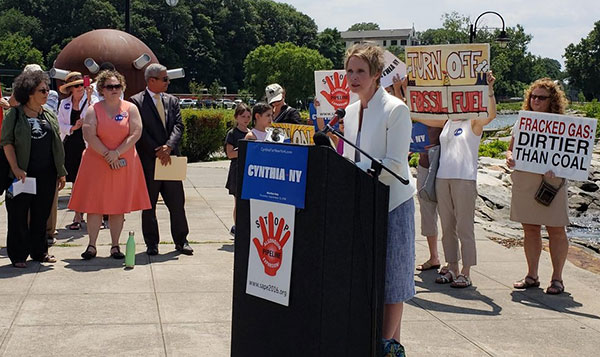
Cynthia Nixon (photo: @CynthiaNixon)
Governor Andrew Cuomo seeks to portray himself as a leading environmentalist. But in reality, he is too wrapped up in his own political ambitions to be the 21st century climate champion New York needs.
The surface is rosy. Governor Cuomo formed the impressive sounding U.S. Climate Alliance, he banned fracking (while building infrastructure to transport fracked gas from nearby states) and is expanding wind farming in the state.
Take a closer look, however, and it’s much seedier.
While portraying himself as a climate leader, Cuomo is hoarding hundreds of thousands of dollars that he has accepted from fossil fuel companies in his campaign war chest. Recently, after facing pressure from constituent advocates and Cynthia Nixon’s candidacy, he said he would no longer accept fossil fuel-funded donations. But then he walked back that pledge, saying he misheard a question, and signaling that he is more concerned with financially positioning himself to run for President -- let’s be honest: he does not need $30 million to run for Governor -- than the wellbeing of his constituents.
With thousands of New Yorkers still recovering from Hurricane Sandy, wildfires scorching the West, and Puerto Rico still not recovered from Maria, there is no excuse for a Governor who claims to be a climate champion but accepts blood money from the fossil fuel industry.
Governor Cuomo has also refused to publicly support the Climate and Community Protection Act, which would shift New York off fossil fuels to a 100% renewable economy by 2050 and has the support of over 100 unions, community groups, and advocacy organizations across New York State. The CCPA has passed the State Assembly multiple times, but has stalled in the Senate, partially due to lack of support from the Governor. When asked about the legislation’s provision for completely shifting New York state to renewable energy over the next 30 years, he insisted it isn’t “practical” to make that rapid a transition.
Polar ice caps will not stop melting to accommodate Andrew Cuomo’s political ambitions nor his sense of practicality. Ask any scientist, and they will tell you that we no longer have time for an incremental approach to climate change. As climate leader Bill McKibben has said, with climate change, winning slowly is the same as losing.
Cynthia Nixon is running on a bold climate action agenda that includes supporting both the Climate and Community Protection Act as well as the Climate and Community Investment Act, which would levy a tax on corporate polluters, generating billions in revenue for investment in renewable energy, green jobs, and resiliency. Most important, Nixon is putting her money where her mouth is -- from the start of her campaign, she has refused all funding from the fossil fuel industry.
Climate consequences are here and only getting worse. Hurricanes supercharged by warming oceans, drought, heat, wildfires, flooding, rising sea levels: it is all underway. Over time, New York will suffer increasingly frequent and devastating storms and floods. Coastal towns will erode into the ocean. Changing weather patterns will impact everything from farms, fisheries, and our food supply to tourism, housing, transportation, and public health.
We need bold, transformative leadership and we need it now. With Donald Trump in Washington, New York needs to aggressively pave its own way into an uncertain, climate-altered future. Cynthia Nixon wants to lead us there by rejecting fossil fuels, protecting vulnerable communities, and embracing a shift to a fairer, renewable energy economy. Andrew Cuomo wants to fill his wallet and run for President.
***
Liat Olenick is a public school science teacher, union leader, and co-president of non-profit Indivisible Nation BK. On Twitter @Liat_RO of @bkindivisible
***
Have an op-ed idea or submission for Gotham Gazette? Email This email address is being protected from spambots. You need JavaScript enabled to view it.
Extending the Human Right of Health Care to All New Yorkers
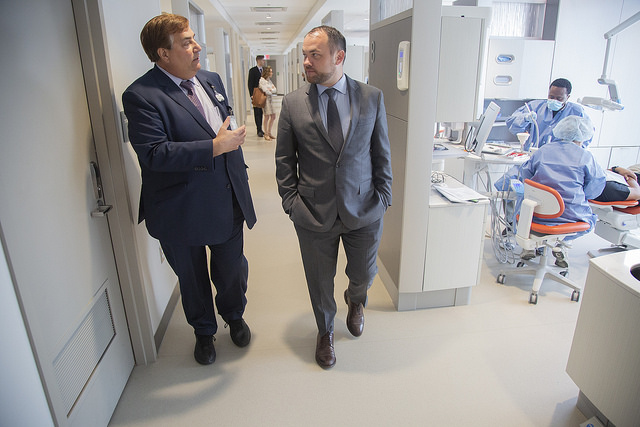
Speaker Johnson, the author, visits a health care facility (photo via John McCarten)
Health care for all is a human right. This means no one should be denied care based on their ability to pay.
The World Health Organization recognized this fundamental truth 70 years ago, most countries around the world have been putting it into action for decades now, and doctors and nurses live it out professionally every day.
Truly achieving this moral imperative means we need a universal health care system supported by taxes and administered by one provider. Not only is this the right thing to do, it’s also more practical and less expensive than the status quo.
A recent study conducted by the RAND Corporation shows that single-payer is likely to save our state health care system $15 billion by 2031 compared to our current system. Other estimates project savings of up to $45 billion.
For these reasons I introduced a resolution Wednesday urging our state government to approve a law that would lay the foundation for single-payer healthcare in the Empire State. The proposal would create the New York Health program, which, if fully implemented, would result in 90 percent of New Yorkers spending less on health care than they currently do.
The plan would help save New Yorkers money by cutting administrative costs and simplifying the present system. Approximately one million New Yorkers are without any health insurance and have essentially been priced out of the market, which is another practical reason why I support this legislation. Also, you, the patient, would pay no premiums, deductibles or co-payments when visiting a doctor under the new system.
According to the RAND study, New Yorkers could spend half as much money out of their own pockets under the New York Health program than they do within the current system. In fact, according to a relatively conservative scenario, New Yorkers with an annual household compensation of less than $105,300 would save about $2,800 per person every year. Other estimates project even greater savings.
Single-payer is traditionally viewed as a progressive cause, but it has earned support from conservative quarters too. RAND, which was originally founded to provide research to the armed forces, isn’t exactly a progressive endeavor.
It is also worth noting that New York is a relatively wealthy state. Our economy is the third largest in the nation, behind California and Texas. And with a gross domestic product of $1.56 trillion, our economy is comparable to Canada’s, which has a $1.65 trillion GDP.
That kind of prosperity is an advantage few states – and few countries, for that matter – enjoy, and it’s one we should leverage so as many New Yorkers as possible have access to good health care. Failing to do so would be an abdication of our responsibility as elected representatives.
The current landscape is complicated and there are a lot of moving parts, but complexity shouldn’t be the enemy of what is right.
President Trump’s administration has signaled it would oppose single-payer plans from state governments seeking to bring sanity to their respective health care landscapes, so it is unlikely his administration will grant New York the federal waivers needed for a single-payer system to be fully implemented here.
However, even without a waiver, the state could still ramp up the program on a partial basis and, in the process, save money for current Medicare and Medicaid recipients through improved, wrap-around coverage. It would also lay the framework for full implementation of the plan under a new president.
Critics on the other side of this debate have also argued that adequate health care shouldn’t be considered a right – that it is a finite resource and can’t be placed in the same category as voting or free speech.
I disagree.
Many human rights we now take for granted in the United States weren’t considered rights at all during various periods of history. But eventually we evolved to see them as such.
The right to vote, freedom of speech, the right to assemble – these are now encoded into our nation’s DNA, but over the course of world history this wasn’t always the case.
Even today, not everyone on earth has the right to vote. Many Americans didn’t have that right immediately after our nation was founded.
But we’ve made progress – often that progress comes too slowly, but there is no progress until we take the first steps forward.
Adopting single-payer healthcare in New York State would be an enormous step in the right direction. This is why I am standing with my colleagues in state government who support it, and I hope you will too.
***
Corey Johnson is the Speaker of the New York City Council and represents the Council’s 3rd District, in Manhattan. On Twitter @NYCSpeakerCoJo.
***
Have an op-ed idea or submission for Gotham Gazette? Email This email address is being protected from spambots. You need JavaScript enabled to view it.
Pay Equity Begins with Paying Black Girls
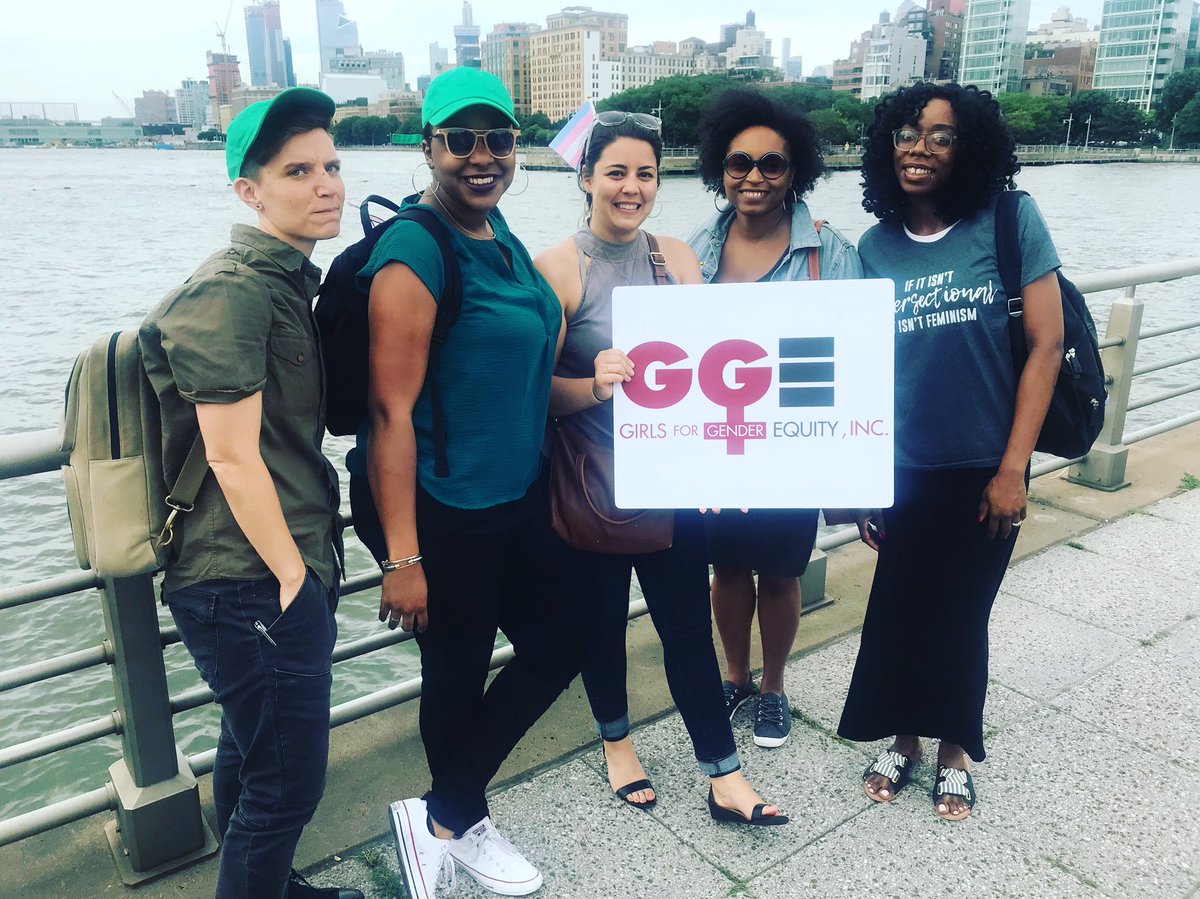
(photo: @GGENYC)
Today, on Black Women’s Equal Pay Day, we recognize the fact that black women would have to work up to today - August 7 - to earn what the average white man earned in 2017.
The reality is that the wage gap that black women in New York City experience is even more stark - a report released this week by New York City Comptroller Scott Stringer noted that black women’s earnings are so low compared to white men that New York City’s Black Women’s Equal Pay Day would fall not in August, but in October.
This of course does not take into account the realities facing the incredibly nuanced experiences of the community - black trans women who face significant barriers in the workforce at every turn, immigrant black women whose labor often is in the shadows of our economy, black women who care for our children and our elders, often at very low pay and in industries that are notorious for labor violations, to name a few.
Today, we consider the existing policies, practices, and systems which prevent black women from receiving their proper remuneration. Families and communities are affected when black women are denied the appropriate pay for their work. So many households in New York City are led by black women, meaning when black women aren’t paid equitably, their children, neighbors, and communities suffer.
In recent years, thanks to the work of our partners at PowHer New York, we have made strides. Section 194 of our state labor law prohibits employers from paying employees of a different gender less for equal work that requires equal skill, effort, and responsibility. In New York City, employers are now banned from inquiring about salary history in the employment application process. Most recently, the City Council introduced legislation to examine the racial gender wage gap in our municipal workforce - women account for 59% of the city’s workforce and two-thirds of those women are women of color.
At Girls for Gender Equity, we know that the wage gap begins early. As a youth-serving organization that invests in the leadership of young cis and trans girls of color and gender non-conforming (GNC) youth, we know that young people of color - especially trans and GNC youth - are locked out of opportunity early on. We ensure that young people whose expertise we value to move our campaigns and organizing strategies forward are compensated for their time.
The concentration of black women in low-wage industries, unchecked workplace violations by bad actors, and employers who continue to undervalue black women’s work all contribute to the racial gender wage gap. If we consider education as a tool to help black and Latinx communities achieve pay equity, our schools can open - and close the doors of economic opportunity.
Black girls and TGNC youth are prevented from having their choice in occupations because of schools that push them out. When a black girl is told she has “too much attitude” or when she starts skipping school to avoid the humiliation of being asked to strip down everyday before going through a metal detector, she doesn’t get to pursue a career that could provide her with a comfortable living wage. Stuyvesant High School, one of the most prestigious New York City high schools, recently offered 13 slots to black students in its freshman class of 1,000. How can we expect black women and girls to be paid equitably when pathways are not created early on for them to thrive?
We say all this also recognizing that even when black women move into managerial positions in the financial sector, they are still paid less than white women and men. The wage gap in New York City is indeed a racial gender wage gap.
Today and everyday we lift up black women and their labor. It is a matter of economic and racial justice.
***
Ashley Sawyer, esq., is director of policy & government relations for Girls for Gender Equity. On Twitter @ACSawyerJustice & @GGENYC.
***
Have an op-ed idea or submission for Gotham Gazette? Email This email address is being protected from spambots. You need JavaScript enabled to view it.
Fostering Feeder Schools Will Improve Diversity at the Specialized High Schools
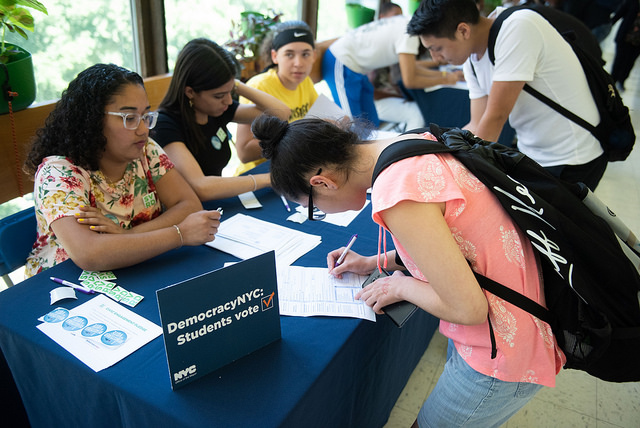
students (photo: Michael Appleton/Mayor's Office)
The public education system in New York City remains one of the most segregated and unequally resourced school systems in the country, reflective of segregation and inequality in other areas of our civic life.
That segregation is starkly obvious in our specialized high schools. In a city where two out of three public high school students are black or Latino, it is unacceptable that they comprise only 10% of the student body across all eight of our elite high schools.
Much has been made recently of Mayor de Blasio’s plan to eliminate the Specialized High Schools Admissions Test, or SHSAT, from the admissions process. The plan is to replace it with a more holistic assessment of achievement based on students’ classroom grades, scores on state standardized English and math tests, and potentially other criteria yet to be determined. But the lack of diversity in our specialized high schools is not a function of the admissions process alone.
The city’s specialized high schools draw from just 21 of the nearly 600 public middle schools citywide. The two Brooklyn City Council districts that we represent factor into this discussion in important ways, and help us draw a path toward improvements to our school system and more diversity at our elite high schools.
Three of these 21 feeder schools are located in the city’s 43rd City Council District in south Brooklyn, with nearly a quarter of all students admitted to specialized high schools coming from School Districts 20, 21, and 22. The schools in these communities are exceptionally diverse, with a majority of students coming from first and second generation immigrant families -- white, black, Hispanic, and Asian alike.
District 16 in central Brooklyn, where schools are 77 percent black and 18.5 percent Hispanic, is a different story. There is not one feeder middle school in District 16, which decades ago had enhanced academics that sent hundreds of students of color to the specialized schools. In fact, until 2015, District 16 schools did not offer the advanced level courses and programming known as “gifted and talented.”
It took pressure from local elected officials forced the Department of Education to provide many majority-minority school districts access to the kind of enhanced academics that provide a pathway to the specialized schools. Despite representing over two-thirds of our public school population, black and Latino students make up only 27% of those enrolled in gifted and talented programs. But even now, the enhanced academics are poorly resourced.
To be sure, improving the admissions process to ensure greater diversity in our specialized high schools is critically important. Expanding access to a great education for minority communities already facing obstacles to their achievement is necessary if we are going to provide equality of opportunity for all New Yorkers.
High-stakes, standardized tests like the SHSAT are poor indicators of students’ potential for success. However, the test is not in itself the problem, and need not be eliminated in order to increase opportunity and diversity. But even with additional methods of assessment, the reality of unequal resources and underinvestment in certain schools would mean improving diversity at our elite high schools will still be a significant challenge.
When you consider that nearly 60% of the middle schools that sent students to specialized high schools were in districts that had gifted and talented schools that required a test for admission, it is evident how decades of unequal investment in enrichment for students of color might be the most significant contributing factor to the city’s problem of diversity in specialized high schools.
Barring state intervention, the students who receive a qualifying score on the SHSAT will continue to be those who have access to test prep and other educational enrichment that most black and Latino students do not.
Today, the National Society of Black Engineers offers test prep to youngsters in District 16 schools to prepare them for tests like the SHSAT. This programming should be expanded, not just to succeed on a test, but to teach how to succeed in life. We must give students enriching experiences that make them connect with learning and foster critical thought and engagement. And we have to do more to create parent awareness and interest in gifted and talented programming.
But it is not enough simply to offer gifted and talented programs and call it a day. The programming provided must be adequately resourced and targeted at the students who are currently underrepresented.
Our colleagues in the City Council agree that the city must restore the funding for enhanced academics in black and Latino communities. As recently as 1989, Brooklyn Tech, for example, was 51 percent black and Latino. As enhanced academics for high-potential students was eliminated in those communities, the percentages of students of color decreased to the point we are at today. We know students, whether in southern or central Brooklyn, can compete successfully if given the resources. They have done it before. They can do it again.
Ending the SHSAT without providing adequate funding and a commitment to educating all students equitably will do nothing to adequately resolve the lack of diversity in our schools, specialized or otherwise.
***
Robert E. Cornegy, Jr. represents the Brooklyn communities of Bedford Stuyvesant and Northern Crown Heights in the New York City Council. Justin Brannan represents Bay Ridge, Dyker Heights, Bath Beach and Bensonhurst in the City Council. On Twitter @RobertCornegyJr & @JustinBrannan.
***
Have an op-ed idea or submission for Gotham Gazette? Email This email address is being protected from spambots. You need JavaScript enabled to view it.
Note: this column has been corrected to reflect that in 1989, Brooklyn Tech was 51 percent black and Latino, not 67 percent as originally stated.
28 Years Later, ADA Non-Compliance Leaves Deaf Patients At Risk

(photo via UCONN)
Imagine being in so much pain that you call 911. Imagine being transported a great distance by an ambulance, all the while in excruciating pain and scared about what might be going on inside your body. Imagine that when you arrive in the hospital, multiple people poke and prod you without telling you what they are doing and without your being able to tell them what you need.
All too frequently, this is the experience of people who are deaf within the United States medical system, because of a complete disregard for the regulations and guidelines set forth in the Americans with Disabilities Act (ADA), which mandate sign language interpreter services.
When former President George H. W. Bush signed the ADA 28 years ago last week, he said, “Let the shameful wall of exclusion finally come tumbling down.” The ADA requires systemic change in how America accommodates people with disabilities, yet more than a quarter of a century after the law’s enactment, pervasive “walls of exclusion” still exist.
New York Lawyers for the Public Interest (NYLPI) recently settled a complaint on behalf of a deaf person in New York City who was denied access to interpreter services at a hospital. It took over six years to resolve the matter, and the client continued to encounter countless similar experiences virtually every time she attempted to schedule an appointment with and visit a medical professional.
This individual is not alone – primary care doctors, specialists, dentists, mental health providers, nursing homes, rehabilitation facilities, and labs routinely deny interpreter services to people who are deaf. This systemic discrimination in the health care setting is illegal under the ADA and has been illegal for even longer in places like New York City, where there are strong state and city non-discrimination laws at play.
The lack of effective communication access is not unique to New York City. The Syracuse University College of Law Disability Rights Clinic also regularly litigates cases of healthcare providers refusing to offer sign language interpreters in upstate New York.
Although there are resources available in New York to hold medical professionals and other agencies accountable if they do not provide effective communication, these problems remain. The New York City Commission on Human Rights and the New York State Division of Human Rights have the ability to investigate and redress such discrimination, even where the individual wants to proceed anonymously. However, these mechanisms are not enough to prevent countless instances of discrimination against members of the deaf community who seek health care.
So if it is illegal, and there are mechanisms for redress, why does the problem persist?
It’s all about money and attitude. There’s a pervasive disregard in the health care profession for the importance of effective communication access for both provider and patient. As an anti-discrimination law, the ADA was intended to enact societal change. However, laws are often not enough – we need a shift in culture.
When deaf individuals speak out about not receiving interpreter services at medical offices, they are often told it is too expensive and providers are reluctant to pay for communication access. The problem is even more acute for solo practitioners than it is for large hospitals and medical practices with deep pockets. The medical community’s failure to budget and plan for this easily anticipated and legally required expense is unacceptable.
Those who speak out are also told they do not really need an interpreter as they can communicate through other means. This is unacceptable.
To require a person who is deaf and deprived effective communication access to seek change, continue to advocate until the change is made, file a lawsuit if the change is not made, and continue to prosecute the lawsuit until it is resolved, is not a realistic solution for creating a more accessible world. It unfairly places the onus on the deaf individual.
There are already models for how to pay for these services. A few years ago, the Monroe County Bar Association established a fund to help defray up to 50 percent of a member’s interpreter bill. Likewise, Title IV of the ADA, which mandates the establishment of a national telephone relay system enabling deaf people to communicate, is funded through a tiny fee collected from everyone’s telephone bill. For health care providers not affiliated with a large institution, a similar fund should be created.
Access delayed is access denied for members of the deaf community when they seek health care. We need creative funding, changes in attitude, and adherence to the law immediately to address this abhorrent situation.
***
Michael Schwartz, Associate Professor of Law at the Syracuse University College of Law, Director of its Disability Rights Clinic, board member at Tangata Group, and a long-time deaf rights advocate; and Maureen Belluscio, Senior Staff Attorney, Disability Justice Program of New York Lawyers for the Public Interest. On Twitter @NYLPI.
***
Have an op-ed idea or submission for Gotham Gazette? Email This email address is being protected from spambots. You need JavaScript enabled to view it.
Key Takeaways from Ocasio-Cortez's Victory
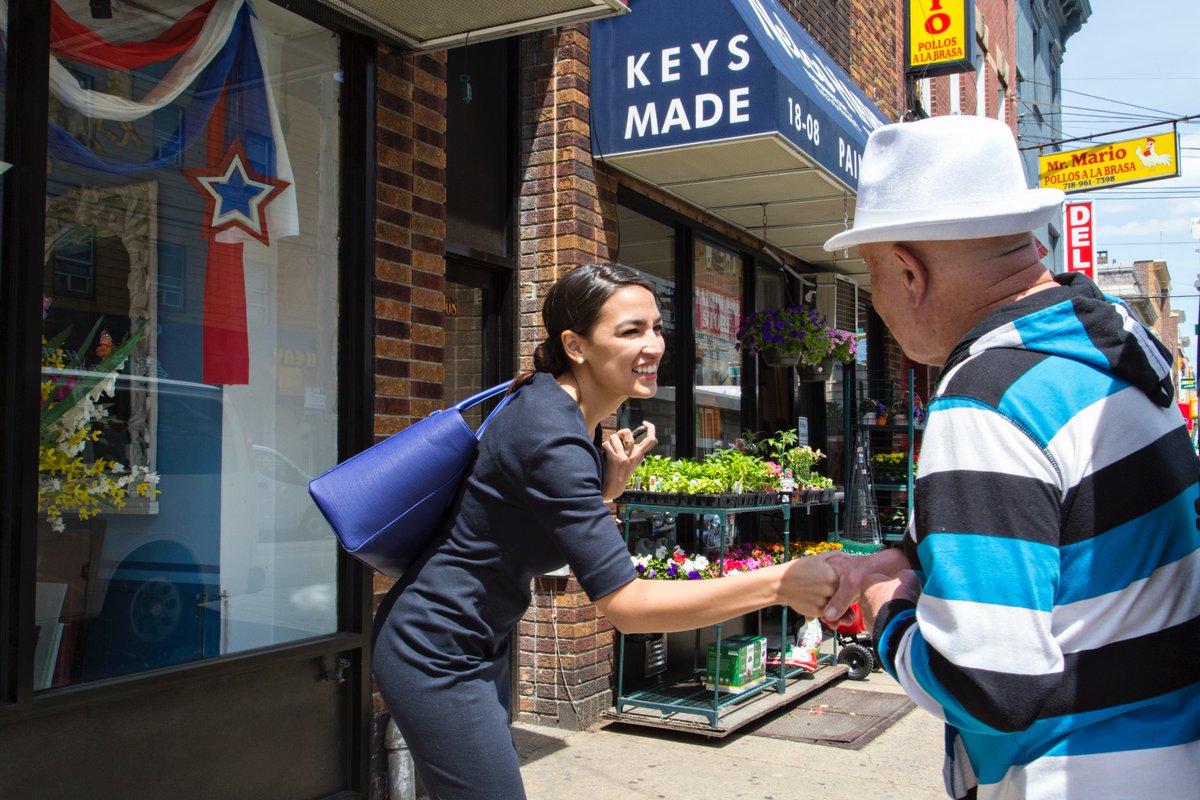
Alexandria Ocasio-Cortez campaigning (photo: @Ocasio2018)
Alexandria Ocasio-Cortez’s victory seems to be misunderstood in a number of ways. First, it is hard to say that it was representative of Democratic Party supporters in the district. Suppose we measure the Democratic Party voters by Crowley’s vote total in the 2016 Congressional election, when he faced no primary opponent and a nominal general election foe (Crowley won 83 percent). The 2018 Democratic primary total -- 28,000 votes -- was only 19.0 percent of this amount.
Indeed, Ocasio-Cortez’s victory reflected the typical outcome of a restrictive voting system favored by the Democratic Party establishment because of its ability to turn out its patronage base. The decline of the patronage base has reduced the turnout of establishment-oriented Democrats while Bernie Sanders has shown the way for a progressive challenger to harness the internet and social media to turn out a base of followers. Thus, Ocasio-Cortez was able to turn the tables on the Democratic Party organization in a low turnout election.
Second, her margin over Crowley was 3,584 in the Queens precincts but only 542 in Bronx precincts. This suggests that her appeal was not primarily to the Latino working-class community but instead the Queens professional class. This thesis is further strengthened by looking at the voter turnout in each borough. In 2016, 66.0% of Crowley’s votes were from Queens whereas in the 2018 primary, 72.4% of the votes were from Queens. Again this is consistent with the Sanders movement.
Despite his principled commitment to working-class politics, Sanders’ message overwhelming resonated with the professional class and little with communities of color. Having a Latina candidate, however, was ideal given the district’s ethnic composition and the desire of Sanders’ supporters to demonstrate their commitment to both far-left politics and multiculturalism.
What happened in the 14th Congressional district certainly reflects the decline of the ability of centrist Democrats to appeal to the anti-Trump movement.
There is also a deeper dynamic at work. In the 1950s, fully one-third of all non-supervisory private-sector personnel were members of unions, giving the Democratic Party a pragmatic working-class base that led to centrist policies.
Similarly, the working class support enabled left-of-center parties in Western Europe and Israel to contest for power with pragmatic centrist policies. In and around 2000, Clinton (U.S.), Blair (U.K.), Schroeder (Germany), Jospin (France), and Barak (Israel) represented victories for this agenda. However, as traditional working-class jobs have declined, as union membership in the private sector has plummeted, this base has shrunk and so too has the support for centrist policies. In the U.K., this has caused a shift in the Labor Party to a much more leftist orientation and this is the direction the Democratic Party has moved in the U.S.; no longer centered around private sector workers but increasingly a party of the professional class and less affluent people of color.
Ocasio-Cortez’s victory crystallizes another important cleavage: the schism between an increasingly active anti-Israel stance among leftist Democrats and the pro-Israel stance of more centrist Democrats. The animus to Israel shown by Democratic Party leader Keith Ellison and candidate Bernie Sanders is amplified by her victory.
She is a member of the Democratic Socialists of America, which has as one of its platforms, support for the Boycott, Divest, and Sanction (BDS) movement. Not only has Ocasio-Cortez not rejected this part of the platform, she has enunciated extreme anti-Israel positions and not shown support for a two-state solution.
How will centrist pro-Israel Democrats deal with this increasingly aggressive anti-Israel stance? Senator Gillibrand, in her courting of the left flank, has embraced Ocasio-Cortez as she did Women’s March leaders who embrace the anti-Semite Louis Farrakhan. However, given his unequivocal support for Israel and rejection of BDS, what will Senator Schumer do? If centrists don’t stand firm on the issue of Israel, it further exposes the demise of the traditional Democratic Party.
***
Robert Cherry is Stern Professor at Brooklyn College and CUNY Graduate Center.
***
Have an op-ed idea or submission for Gotham Gazette? Email This email address is being protected from spambots. You need JavaScript enabled to view it.
Note: this article has been corrected with the intended French leader, Jospin.
Deadline Approaching to Protect Title X and Our Right to Critical Health Care
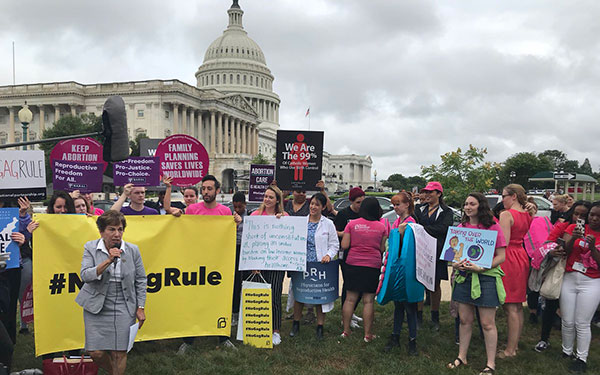
(photo: @PPact)
If it were not for Planned Parenthood, I’m not sure where I would have gotten critical health care services that I needed. And now, the Trump-Pence administration is trying to take that access away.
The Trump-Pence Administration recently announced a proposed new rule on the Title X federal family planning program designed to make it impossible for patients like me to get birth control or preventive care from reproductive health care providers like Planned Parenthood.
With the resignation of Supreme Court Justice Anthony Kennedy and the nomination of Brett Kavanaugh, the future of reproductive health policy in the United States is further in jeopardy. Title X is the nation’s family planning program that helps ensure that everyone can access birth control, STD testing, and treatment and other preventive care, regardless of income. Four million people, including 150,000 in New York City, benefit from Title X funding every year.
Under Trump’s proposed “domestic gag rule,” any health care provider who provides abortion, refers patients for abortion, or even mentions the word “abortion” would no longer be able to receive Title X funding.
In 2008, my mom was diagnosed with late-stage fallopian tube cancer, a rare gynecological cancer sometimes found in Ashkenazi Jewish women. My family was heartbroken. We not only had to worry about getting my mom better, but also finding out if this would be a disease that affected me as well. I was attending Hunter College and spent half my week going to school and the other half taking care of my mom as she underwent chemotherapy. In those chemo rooms, I learned how many women were ignored by their doctors when they shared their symptoms and how many didn't know they were genetically predisposed to this illness before it was too late.
Ovarian cancer is known as “the silent killer” and I wanted to do whatever I could to avoid being another woman who lost her life to this horrible illness. My mom's doctor informed me going on birth control pills was the only preventative measure. There was one hiccup though -- I didn't have health insurance. This was before the Affordable Care Act passed and I couldn't afford the monthly cost of the birth control. CVS charged $160 for the brand of birth control pills I needed. As a college student, it was unfathomable.
A friend told me about Planned Parenthood of New York City (PPNYC). So I went to the location downtown, nervous I couldn't afford my bill, but determined to take control of my health. I had a checkup and found out I could get the exact brand of birth control pills I needed for $20 per month. When I went to pay for my visit, I found out it was free thanks to their sliding scale that factors in a person's income. At a time when I was terrified and confused, PPNYC showed me compassion and gave me the tools I needed to be confident in my own health, while taking care of my mom and being a college student.
My mom is now eight years in remission and I graduated from college a triple major. As a writer and performer in New York City, I still use Planned Parenthood of New York City today for my health care. I'm so grateful to be able to continue to have this resource in my life and I lend my voice whenever possible so it can continue to have its doors open for all people, regardless of gender, immigration status, or ability to pay.
The Title X program helped me access affordable birth control from PPNYC, and we need to fight to make sure this program continues to help people like me. In New York, Planned Parenthood serves 52% of patients who get care through Title X. It includes critical preventive services like birth control, cancer screenings, STI testing and treatment, and well-woman exams. It has bipartisan support and is part of the reason we’re at a 30-year low for unintended pregnancy in the United States.
The Trump-Pence Administration doesn’t care how many people they hurt. A domestic gag rule on Title X providers would have devastating consequences and threaten health care for millions. All people deserve access to high-quality health care and critical, medically accurate information about their bodies.
Planned Parenthood of New York City was there for me when no one else was, and helped me take control of my future. I proudly stand with them as they fight against these regressive policies that take away our right to make the health decisions best for us. You can join us in the fight for our reproductive health care by posting a public comment to the Department of Health and Human Services site by July 31 demonstrating your opposition to the domestic gag rule and why each and every one of us deserves reproductive freedom.
***
RoseAnn Fino lives in Astoria and is a patient at Planned Parenthood of New York City.
***
Have an op-ed idea or submission for Gotham Gazette? Email This email address is being protected from spambots. You need JavaScript enabled to view it.
Lives at Stake: Senate Must Reconvene Immediately to Pass Speed Safety Camera Bill
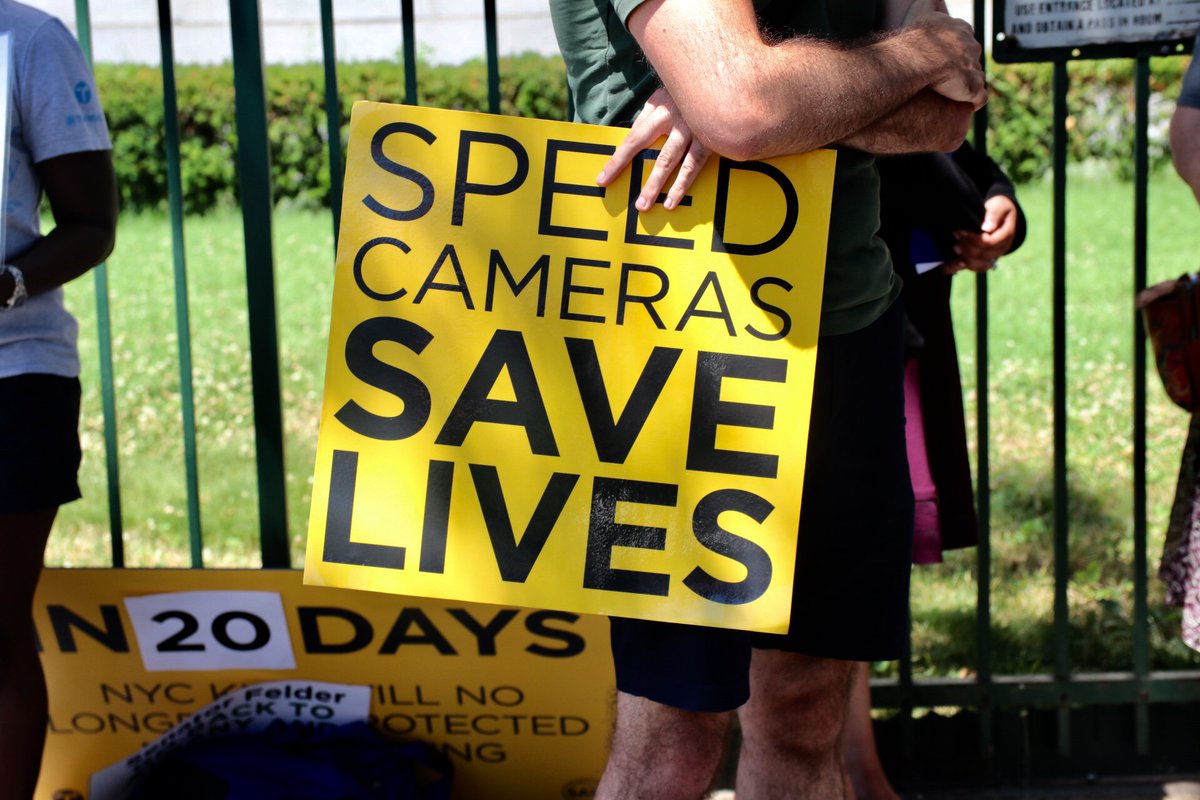
(photo: @NYC_SafeStreets)
No parent expects that a kiss goodbye on a seemingly normal day will end as it did. A phone call from the police. A frantic trip from a parent-teacher conference to the emergency room. Hours waiting with friends, Sammy’s pediatrician, and family. Praying for him to live but prayers turning out to not be enough.
We should never have met. A social worker, parent, and concerned-but-not-an-activist Brooklynite and a committed elected official from Manhattan. But this unimaginable event brought us together in pursuit of a common goal.
The rage and heart-wrenching pain needed an outlet. So we met, and met again -- at rallies, press conferences and meetings. Now together, we fight for a common goal: to protect New York City schoolchildren and to change the culture of reckless driving that is killing someone like Sammy on our streets every 38 hours.
We have a preventable public health crisis. It was a silent epidemic before we met. But now this crisis is gaining widespread recognition, as is a proven life-saving remedy: speed safety cameras.
New York City’s permission to operate 140 speed safety cameras in school zones is expiring. All of the cameras are about to be turned off. All because of inaction by the New York State Senate. But, the Senate can remedy this by reconvening in Albany and passing the life-saving bill that awaits its members.
After a four-year pilot, the data is conclusive: speed safety cameras work. They have reduced speeding, a leading cause of death and injury on New York City streets, by more than 63 percent, according to the New York City Department of Transportation. And at a time when traffic deaths have been on the rise across the United States as a whole -- traffic deaths climbed 14 percent nationally between 2015 and 2016 -- here in New York City, we have watched traffic deaths fall by 28 percent since speed safety cameras were switched on in 2014.
Simply put, if we can conquer the speeding epidemic, we can achieve Vision Zero and prevent people from dying. We’re making progress. Together, we helped pass the state Assembly bill (A.7798C) to expand the speed safety camera program to 290 school zones and allow the cameras to be placed on the most dangerous streets near schools, not just directly in front of school entrances. This bill has the support of over 300 organizations across the city and 77 percent of New York City voters, and has 34 co-sponsors -- including three Republicans -- in the Republican-led Senate.
The Senate needs to reconvene and pass this bill immediately. For Sammy. For all New York City schoolchildren, and for all New Yorkers.
***
Amy Cohen is a founding member of Families for Safe Streets. Deborah J. Glick is a New York State Assembly member representing the 66th District in Lower Manhattan and is the prime sponsor of the speed camera school safety bill. On Twitter @NYC_SafeStreets & @DeborahJGlick.
***
Have an op-ed idea or submission for Gotham Gazette? Email This email address is being protected from spambots. You need JavaScript enabled to view it.